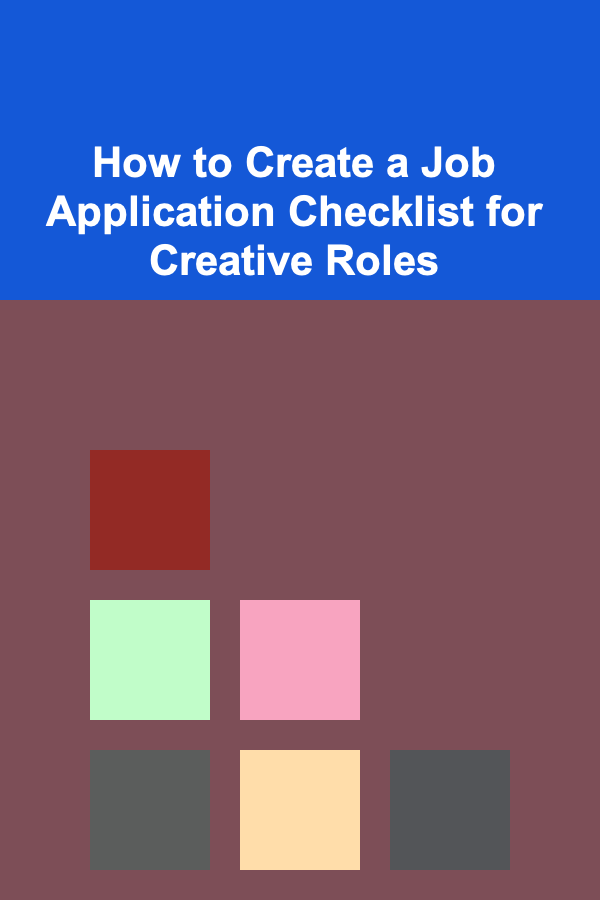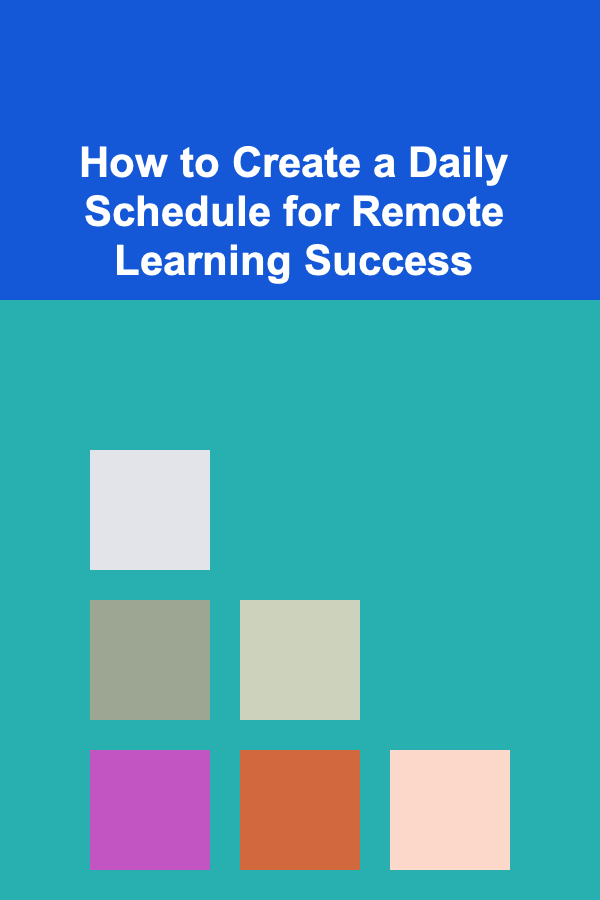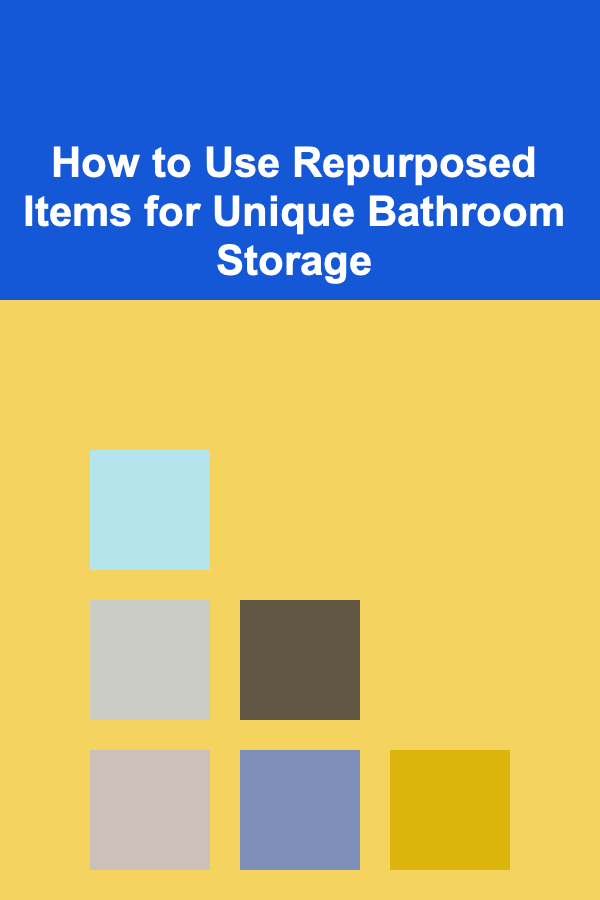
How to Create a Job Application Checklist for Creative Roles
ebook include PDF & Audio bundle (Micro Guide)
$12.99$7.99
Limited Time Offer! Order within the next:

When hiring for creative positions, whether in design, writing, marketing, or other fields, it's important to structure the job application process in a way that highlights the applicant's unique skills and qualifications while maintaining a fair and efficient evaluation process. Creative roles often require more than just a resume and cover letter; they demand a portfolio, relevant samples, and often a demonstration of specific skills.
A well-crafted job application checklist ensures that both the recruiter and the applicant are on the same page, reducing the risk of overlooking important criteria or missing out on top talent. This article will walk you through the steps of creating an effective job application checklist for creative roles.
Define the Job Requirements and Expectations
Before you begin crafting a job application checklist, it's essential to clearly define what you are looking for in the applicant. Creative roles can be diverse, and the requirements can vary greatly between different positions. Understanding these differences will help you tailor your checklist to ensure that all key qualifications are addressed.
Key Considerations When Defining Job Requirements:
- Job Title and Department: Is this a graphic designer, copywriter, content creator, art director, or another creative role? Knowing the job title will help in drafting the appropriate qualifications and skillsets.
- Skills Required: Do you need a candidate with proficiency in certain software (e.g., Adobe Creative Suite, Final Cut Pro, etc.)? Do you need specific writing styles, digital marketing knowledge, or hands-on design experience?
- Experience Level: Are you looking for someone with years of experience in the field, or are entry-level candidates acceptable? Define what's necessary to succeed in this role.
- Cultural Fit and Values: Creative roles often require collaboration and alignment with company values. Consider whether the applicant will mesh well with your team dynamic.
Example Job Description Elements:
- Graphic Designer: Proficient in Adobe Illustrator, Photoshop, and InDesign. 3+ years of professional experience required.
- Copywriter: Excellent written communication skills with experience in SEO and content marketing.
- Art Director: Strong understanding of visual communication, typography, and brand development.
Once the requirements are set, you can create a checklist that matches the key components of the job description.
Build the Core Job Application Checklist
With job requirements in mind, here's how to structure a comprehensive job application checklist that ensures you capture all necessary components when evaluating a creative applicant.
Checklist for the Applicant:
-
Resume or CV
- A professional, up-to-date resume highlighting the candidate's relevant work experience and education.
- Include any specialized training, certifications, or software skills relevant to the creative field.
- Ensure the resume is tailored to the role, with focus on creative accomplishments.
-
Cover Letter
- A brief cover letter (ideally no longer than one page) explaining why the candidate is interested in the position, why they believe they are a good fit, and how their skills and experiences align with the company's needs.
- Look for originality and clarity in writing, as the cover letter itself is a demonstration of the candidate's ability to communicate creatively.
-
Portfolio
- The portfolio is often the most critical element in a creative role application. It should showcase the candidate's best work and demonstrate a clear understanding of the specific role they are applying for.
- The portfolio should be easy to navigate, organized by project type or category (e.g., branding, UI/UX design, advertising).
- Include at least 5-10 representative pieces of work with clear explanations of the candidate's contribution to each project. For example, did they design the entire brand from scratch, or were they responsible for specific components of the design?
-
Relevant Samples
- Depending on the role, ask candidates to provide specific samples. For example:
- Design roles: Ask for a selection of logos, posters, websites, or other visual work.
- Writing roles: Request samples of blog posts, advertising copy, or social media content.
- Marketing roles: Ask for campaign examples, email newsletters, or marketing strategy documents.
- If the candidate doesn't have work samples directly related to the role, request that they complete a small, short task or assignment.
- Depending on the role, ask candidates to provide specific samples. For example:
-
References
- Obtain at least two professional references who can speak to the candidate's creative abilities, work ethic, and ability to collaborate in a creative environment.
-
Online Presence
- Creative professionals often maintain an online presence through websites or social media profiles (e.g., LinkedIn, Behance, Instagram, Dribbble). Ask applicants to provide links to any of their relevant online portfolios, profiles, or accounts that show their ongoing work.
- If applicable, check if the candidate has a blog, YouTube channel, or other digital platform that showcases their work and passion.
-
Software Proficiency
- Ask for specific examples of how the candidate has used relevant software in past roles. For example, did they work with a team to design an app interface using Sketch or Figma, or have they edited video using Adobe Premiere Pro?
- Check if the candidate holds certifications in any of these tools, as this can be an indicator of their level of expertise.
-
Creative Challenges or Tasks
- Depending on the role and organization, you might want to include a creative challenge or task as part of the application process. For example:
- A graphic designer could be asked to create a logo in a specified style.
- A writer might be asked to write a short blog post on a particular topic.
- A marketer could be asked to design a social media campaign concept.
- Creative challenges allow you to evaluate a candidate's real-time problem-solving skills and approach to creative work.
- Depending on the role and organization, you might want to include a creative challenge or task as part of the application process. For example:
Evaluation and Scoring System
Once the candidate has submitted their application materials, it's time to review and evaluate them. Establishing a clear evaluation and scoring system will help you maintain objectivity and consistency when reviewing creative applicants. Here's a suggested evaluation process:
Key Areas to Evaluate:
- Creativity: Does the applicant's work stand out as original, fresh, and innovative? Look for unique approaches to problem-solving.
- Technical Skills: Does the applicant demonstrate proficiency in the tools and techniques required for the job? Are they adept with design software, content management systems, or any other relevant tools?
- Attention to Detail: How well does the applicant pay attention to detail in their work? This is crucial, especially in creative fields where small design flaws, grammatical errors, or missed deadlines can be costly.
- Communication Skills: Can the candidate effectively communicate their ideas, both in writing and verbally? In creative roles, presenting ideas clearly and working with a team are crucial aspects of the job.
- Portfolio Quality: Evaluate the overall quality and diversity of the portfolio. Are the projects varied, and do they demonstrate the necessary skills for the role?
- Cultural Fit: Does the candidate's approach to creativity align with the culture of your organization? How well would they integrate into the team?
Consider using a scoring system (e.g., a 1-5 scale) for each of these areas. For example:
- Creativity: 4/5
- Technical Skills: 3/5
- Portfolio Quality: 5/5
This scoring system will help you keep track of your impressions and make more informed decisions.
Streamlining the Interview Process
After narrowing down the pool of applicants based on their application materials, it's time to invite the most promising candidates to an interview. While creative applicants may excel in a portfolio or on paper, the interview process provides deeper insight into their personality, communication skills, and ability to collaborate with others.
Interview Questions to Ask:
- Tell us about a creative project you are particularly proud of and why.
- How do you handle creative feedback or criticism?
- Can you walk us through your creative process when starting a new project?
- Describe a time when you had to meet a tight deadline. How did you manage the pressure while maintaining creativity?
- How do you stay updated with the latest trends and tools in your creative field?
- What excites you most about working in a creative team?
The interview should focus on uncovering the candidate's approach to creativity, problem-solving, and collaboration. Since creative roles often involve teamwork, it's essential to understand how they will work within a group dynamic.
Finalizing the Job Application Checklist
As you finalize your checklist, ensure that it's comprehensive yet not overly complicated. Keep it focused on the key elements that align with the specific role and your company's needs. Make sure that the checklist includes the following items:
- Job title and clear expectations.
- Skills and qualifications required.
- Portfolio requirements with specific examples.
- Additional relevant samples or challenges.
- A clear scoring system for evaluating candidates.
- Interview questions tailored to creative candidates.
This checklist should be used consistently across all applicants to ensure a fair and transparent evaluation process.
Conclusion
A job application checklist for creative roles is an invaluable tool for hiring managers and recruiters. It ensures that all necessary materials are submitted, evaluates candidates based on key criteria, and provides a streamlined process for managing the influx of creative applicants. By defining job requirements clearly, building a robust checklist, and using a consistent evaluation method, you can make more informed hiring decisions that ultimately lead to the best candidates joining your creative team.
Reading More From Our Other Websites
- [Home Party Planning 101] How to Plan a Budget-Friendly Party Without Skimping on Fun
- [Home Security 101] How to Upgrade Your Home's Security After a Break-in
- [Home Holiday Decoration 101] How to Add a Touch of Glam to Your Holiday Decorations
- [Organization Tip 101] Why You Need to Involve Your Family in Home Organization
- [Ziplining Tip 101] Swinging Through the Emerald Canopy: Top Zipline & Canopy Walk Combos in South America's Rainforests
- [Personal Investment 101] How to Get the Most Out of Investment Seminars and Courses
- [Home Budget Decorating 101] How to Mix High-End and Budget Finds for a Designer Look
- [Tie-Dyeing Tip 101] How to Achieve Professional‑Level Tie‑Dye on Leather Sneakers Without Cracking
- [Organization Tip 101] How to Involve Local Businesses in Supporting Your Reunion
- [Personal Care Tips 101] How to Get the Perfect Lash Lift Using Mascara

How to Choose the Best Lighting for Your Bedroom
Read More
How to Create a Daily Schedule for Remote Learning Success
Read More
How to Decorate a Rental Property Without Losing Your Deposit
Read More
How to Use Repurposed Items for Unique Bathroom Storage
Read More
How To Master Time-Lapse Photography
Read More
How to Begin a Career in AI
Read MoreOther Products

How to Choose the Best Lighting for Your Bedroom
Read More
How to Create a Daily Schedule for Remote Learning Success
Read More
How to Decorate a Rental Property Without Losing Your Deposit
Read More
How to Use Repurposed Items for Unique Bathroom Storage
Read More
How To Master Time-Lapse Photography
Read More